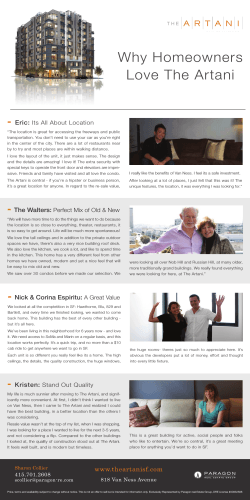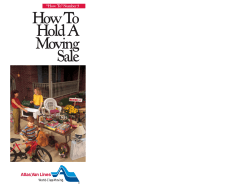
Software Life Cycle Main issues: Discussion of different life cycle models
Software Life Cycle
Main issues:
Discussion of different life cycle models
Maintenance or evolution
Not this life cycle
SE, Software Lifecycle, Hans van Vliet, ©2008
2
Introduction
software development projects are large and
complex
a phased approach to control it is necessary
traditional models are document-driven: there is a
new pile of paper after each phase is completed
evolutionary models recognize that much of what
is called maintenance is inevitable
latest fashion: agile methods, eXtreme
Programming
life cycle models can be explicitly modeled, in a
process modeling language
SE, Software Lifecycle, Hans van Vliet, ©2008
3
Simple life cycle model
problem
requirements engineering
reqs specification
design
design
implementation
system
testing
working system
maintenance
SE, Software Lifecycle, Hans van Vliet, ©2008
4
Point to ponder #1
Why does the model look like this?
Is this how we go about?
SE, Software Lifecycle, Hans van Vliet, ©2008
5
Simple Life Cycle Model
document driven, planning driven, heavyweight
milestones are reached if the appropriate
documentation is delivered (e.g., requirements
specification, design specification, program, test
document)
much planning upfront, often heavy contracts are
signed
problems
feedback is not taken into account
maintenance does not imply evolution
SE, Software Lifecycle, Hans van Vliet, ©2008
6
Waterfall Model
reqs engineering
V&V
design
V&V
implementation
V&V
testing
V&V
maintenance
V&V
SE, Software Lifecycle, Hans van Vliet, ©2008
7
Another waterfall model
testing
feedback
implementation
design
requirements
engineering
SE, Software Lifecycle, Hans van Vliet, ©2008
8
V-Model
acceptance
testing
reqs eng
integration
testing
global design
unit testing
det. design
coding
SE, Software Lifecycle, Hans van Vliet, ©2008
9
Waterfall Model (cntd)
includes iteration and feedback
validation (are we building the right system?) and
verification (are we building the system right?)
after each step
user requirements are fixed as early as possible
problems
too rigid
developers cannot move between various abstraction levels
SE, Software Lifecycle, Hans van Vliet, ©2008
10
Activity versus phase
Phase
Activity
Design
Implementation
Integration
testing
Acceptance
testing
Integration
testing
4.7
43.4
26.1
25.8
Implementation
(& unit testing)
6.9
70.3
15.9
6.9
Design
49.2
34.1
10.3
6.4
SE, Software Lifecycle, Hans van Vliet, ©2008
11
Lightweight (agile) approaches
prototyping
incremental development
RAD, DSDM
XP
SE, Software Lifecycle, Hans van Vliet, ©2008
12
The Agile Manifesto
Individuals and interactions over processes and
tools
Working software over comprehensive
documentation
Customer collaboration over contract negotiation
Responding to change over following a plan
SE, Software Lifecycle, Hans van Vliet, ©2008
13
Prototyping
requirements elicitation is difficult
software is developed because the present situation is
unsatisfactory
however, the desirable new situation is as yet unknown
prototyping is used to obtain the requirements of
some aspects of the system
prototyping should be a relatively cheap process
use rapid prototyping languages and tools
not all functionality needs to be implemented
production quality is not required
SE, Software Lifecycle, Hans van Vliet, ©2008
14
Prototyping as a tool for
requirements engineering
reqs engineering
design
implementation
testing
design
implementation
testing
maintenance
SE, Software Lifecycle, Hans van Vliet, ©2008
15
Prototyping (cntd)
throwaway prototyping: the n-th prototype is
followed by a waterfall-like process (as depicted
on previous slide)
evolutionary prototyping: the nth prototype is
delivered
SE, Software Lifecycle, Hans van Vliet, ©2008
16
Point to ponder #2
What are the pros and cons of the two approaches?
SE, Software Lifecycle, Hans van Vliet, ©2008
17
Prototyping, advantages
The resulting system is easier to use
User needs are better accommodated
The resulting system has fewer features
Problems are detected earlier
The design is of higher quality
The resulting system is easier to maintain
The development incurs less effort
SE, Software Lifecycle, Hans van Vliet, ©2008
18
Prototyping, disadvantages
The resulting system has more features
The performance of the resulting system is worse
The design is of less quality
The resulting system is harder to maintain
The prototyping approach requires more
experienced team members
SE, Software Lifecycle, Hans van Vliet, ©2008
19
Prototyping, recommendations
the users and the designers must be well aware of
the issues and the pitfalls
use prototyping when the requirements are
unclear
prototyping needs to be planned and controlled
as well
SE, Software Lifecycle, Hans van Vliet, ©2008
20
Incremental Development
a software system is delivered in small
increments, thereby avoiding the Big Bang effect
the waterfall model is employed in each phase
the user is closely involved in directing the next
steps
incremental development prevents
overfunctionality
SE, Software Lifecycle, Hans van Vliet, ©2008
21
RAD: Rapid Application Development
evolutionary development, with time boxes: fixed
time frames within which activities are done;
time frame is decided upon first, then one tries to
realize as much as possible within that time
frame;
other elements: Joint Requirements Planning
(JRD) and Joint Application Design (JAD),
workshops in which users participate;
requirements prioritization through a triage;
development in a SWAT team: Skilled Workers
with Advanced Tools
SE, Software Lifecycle, Hans van Vliet, ©2008
22
DSDM
Dynamic Systems Development Method, #1 RAD
framework in UK
Fundamental idea: fix time and resources
(timebox), adjust functionality accordingly
One needs to be a member of the DSDM
consortium
SE, Software Lifecycle, Hans van Vliet, ©2008
23
DSDM phases
Feasibility: delivers feasibility report and outline
plan, optionally fast prototype (few weeks)
Business study: analyze characteristics of
business and technology (in workshops), delivers
a.o. System Architecture Definition
Functional model iteration: timeboxed iterative,
incremental phase, yields requirements
Design and build iteration
Implementation: transfer to production
environment
SE, Software Lifecycle, Hans van Vliet, ©2008
24
DSDM practices
Active user involvement is imperative
Empowered teams
Frequent delivery of products
Acceptance determined by fitness for business
purpose
Iterative, incremental development
All changes are reversible
Requirements baselined at high level
Testing integrated in life cycle
Collaborative, cooperative approach shared by all
stakeholders is essential
SE, Software Lifecycle, Hans van Vliet, ©2008
25
XP – eXtreme Programming
Everything is done in small steps
The system always compiles, always runs
Client as the center of development team
Developers have same responsibility w.r.t.
software and methodology
SE, Software Lifecycle, Hans van Vliet, ©2008
26
13 practices of XP
Whole team: client part
of the team
Metaphor: common
analogy for the system
The planning game,
based on user stories
Simple design
Small releases (e.g. 2
weeks)
Customer tests
Pair programming
Test-driven
development: tests
developed first
Design improvement
(refactoring)
Collective code
ownership
Continuous integration:
system always runs
Sustainable pace: no
overtime
Coding standards
SE, Software Lifecycle, Hans van Vliet, ©2008
27
RUP
Rational Unified Process
Complement to UML (Unified Modeling Language)
Iterative approach for object-oriented systems,
strongly embraces use cases for modeling
requirements
Tool-supported (UML-tools, ClearCase)
SE, Software Lifecycle, Hans van Vliet, ©2008
28
RUP phases
Inception: establish scope, boundaries, critical
use cases, candidate architectures, schedule and
cost estimates
Elaboration: foundation of architecture, establish
tool support, get al use cases
Construction: manufactoring process, one or
more releases
Transition: release to user community, often
several releases
SE, Software Lifecycle, Hans van Vliet, ©2008
29
Two-dimensional process structure of RUP
SE, Software Lifecycle, Hans van Vliet, ©2008
30
Differences for developers
Agile: knowledgeable, collocated, collaborative
Heavyweight: plan-driven, adequate skills, access
to external knowledge
SE, Software Lifecycle, Hans van Vliet, ©2008
31
Differences for customers
Agile: dedicated, knowledgeable, collocated,
collaborative, representative, empowered
Heavyweight: access to knowledgeable,
collaborative, representative, empowered
customers
SE, Software Lifecycle, Hans van Vliet, ©2008
32
Differences for requirements
Agile: largely emergent, rapid change
Heavyweight: knowable early, largely stable
SE, Software Lifecycle, Hans van Vliet, ©2008
33
Differences for architecture
Agile: designed for current requirements
Heavyweight: designed for current and
foreseeable requirements
SE, Software Lifecycle, Hans van Vliet, ©2008
34
Differences for size
Agile: smaller teams and products
Heavyweight: larger teams and products
SE, Software Lifecycle, Hans van Vliet, ©2008
35
Differences for primary objective
Agile: rapid value
Heavyweight: high assurance
SE, Software Lifecycle, Hans van Vliet, ©2008
36
The advantages of screen wipers
SE, Software Lifecycle, Hans van Vliet, ©2008
37
MDA – Model Driven Architecture
model
maintenance
implementation
transformation
code
maintenance
SE, Software Lifecycle, Hans van Vliet, ©2008
38
Essence of MDA
Platform Independent Model (PIM)
Model transformation and refinement
Resulting in a Platform Specific Model (PSM)
SE, Software Lifecycle, Hans van Vliet, ©2008
39
Maintenance or Evolution
some observations
systems are not built from scratch
there is time pressure on maintenance
the five laws of software evolution
law of continuing change
law of increasingly complexity
law of program evolution
law of invariant work rate
law of incremental growth limit
SE, Software Lifecycle, Hans van Vliet, ©2008
40
Illustration third law of Software Evolution
system
attributes
time
SE, Software Lifecycle, Hans van Vliet, ©2008
41
Software Product Lines
developers are not inclined to make a
maintainable and reusable product, it has
additional costs
this viewpoint is changed somewhat if the product
family is the focus of attention rather than
producing a single version of a product
two processes result: domain engineering, and
application engineering
SE, Software Lifecycle, Hans van Vliet, ©2008
42
Process modeling
we may describe a software-development
process, or parts thereof, in the form of a
“program” too. E.G.:
function review(document, threshold): boolean;
begin prepare-review;
hold-review{document, no-of-problems);
make-report;
return no-of-problems < threshold
end review;
SE, Software Lifecycle, Hans van Vliet, ©2008
43
STD of review process
coding
ready
ready for
next step
submit
review
re-review
prepare
do
ready
make
done
report ready
report
SE, Software Lifecycle, Hans van Vliet, ©2008
44
Petri-net view of the review process
code
ready
from
hold
review
code
update
revised
code
coding
end
next
step
from
management
scheduled
minutes
SE, Software Lifecycle, Hans van Vliet, ©2008
45
Purposes of process modeling
facilitates understanding and communication by
providing a shared view of the process
supports management and improvement; it can be
used to assign tasks, track progress, and identify
trouble spots
serves as a basis for automated support (usually
not fully automatic)
SE, Software Lifecycle, Hans van Vliet, ©2008
46
Caveats of process modeling
not all aspects of software development can be
caught in an algorithm
a model is a model, thus a simplification of reality
progression of stages differs from what is actually
done
some processes (e.g. learning the domain) tend to
be ignored
no support for transfer across projects
SE, Software Lifecycle, Hans van Vliet, ©2008
47
Summary
Traditional models focus on control of the
process
There is no one-size-fits-all model; each situation
requires its own approach
A pure project approach inhibits reuse and
maintenance
There has been quite some attention for process
modeling, and tools based on such process
models
SE, Software Lifecycle, Hans van Vliet, ©2008
48
© Copyright 2026









